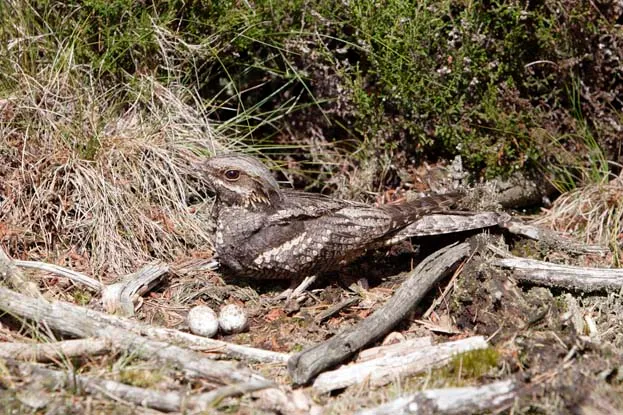1. Short-term visitors
The nightjar is one of our most fascinating summer migrants. They’re only here for a few weeks in the summer, arriving in late May and leaving by mid-August. Until the mid-2000s we knew little about their migration and wintering sites, but through BTO tracking work we now know that they winter in southern Africa.
2. Where to see them
You can find nightjars in much of Britain, as long as there is suitable habitat. While their population increased by 35 per cent between 1992 and 2004, they are still Amber listed. Lack of available breeding habitat is thought to be a major issue for the species.
3. Habitat preferences
Typically nightjars nest in heathland and young conifer plantations to the point where birds will move territory as areas of young growth in forest plantations change within the management cycle. Recent BTO tracking work has shown that newly planted forest and grazed grassland, within a close distance to the nest, could also be important for feeding.

The plumage of the nightjar is perfect for camouflage. © John Proudlock/BTO
4. Nightjar folklore
Due to their elusive nocturnal habits, nightjars have been the basis for many myths and legends. In many European countries, the nightjar is known as a ‘goatsucker’ after its Latin name, as they were believed to feed from goats due to the fact that they were often found in close proximity to livestock; we now know that the attraction is the invertebrates associated with livestock.
5. Listen out
While you may be lucky to see a nightjar silhouetted against the sky at dusk as it searches for insects, you are much more likely to hear one. The male has a unique ‘churring’ call which can contain up to 1900 notes a minute!
6. How to identify a nightjar
Thanks to its brown and black tree-bark-like plumage, the nightjar is hard to see during the daytime when it fades into the background. This plumage is especially important for the female as they are a ground-nesting bird. Adults have a flat, wide head and large eyes that aid their sight at night. In flight, they have obviously long wings and tails and males can be told from females by their white wing and tail patches.
The British Trust of Ornithology (BTO) works in partnership with over 40,000 volunteer birdwatchers to chart the fortunes of UK birds.
The BTO coordinates BirdTrack, a system that allows you to keep a record of the birds you have seen whilst contributing to our birds in Britain and Ireland and beyond.
This is a partnership project between the BTO, the RSPB, Birdwatch Ireland, the Scottish Ornithologists’ Club and the Welsh Ornithological Society.
For more information about BirdTrack, including how to take part, please visit www.birdtrack.net.
